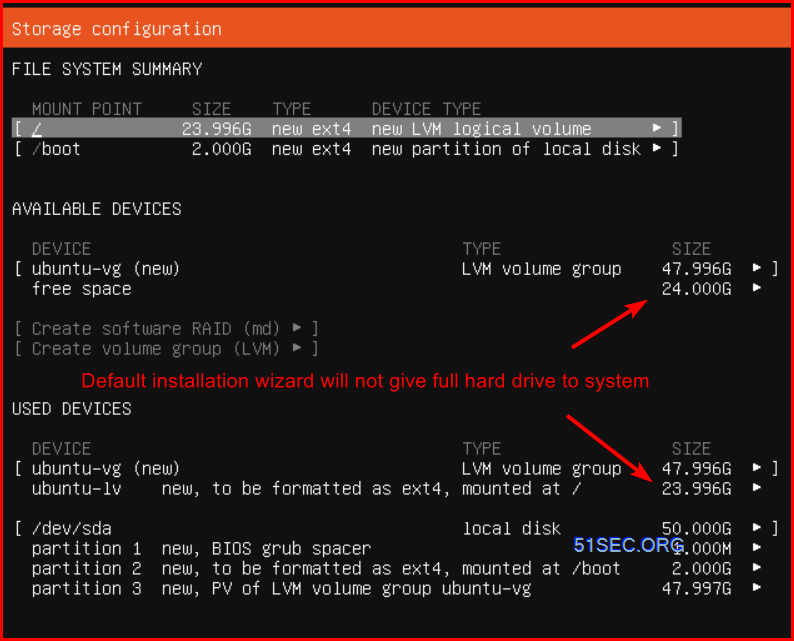Issue
If you use Ubuntu default configuration and it might not use all of your hard drive for your partitions.
You will see some free space during installation wizard. If you did not change it to use all hard drive space, you might need to re-allocate your free space later.
Steps
Here are some steps if you are facing same issue.
0) #df -h
Filesystem Size Used Avail Use% Mounted on
devtmpfs 1.9G 0 1.9G 0% /dev
tmpfs 1.9G 0 1.9G 0% /dev/shm
tmpfs 1.9G 824K 1.9G 1% /run
tmpfs 1.9G 0 1.9G 0% /sys/fs/cgroup
/dev/mapper/fedora-root 15G 2.1G 13G 14% /
tmpfs 1.9G 0 1.9G 0% /tmp
/dev/md126p1 976M 119M 790M 14% /boot
tmpfs 388M 0 388M 0% /run/user/0
1) # vgs
VG #PV #LV #SN Attr VSize VFree
fedora 1 2 0 wz--n- 231.88g 212.96g
2) # vgdisplay
--- Volume group ---
VG Name fedora
System ID
Format lvm2
Metadata Areas 1
Metadata Sequence No 3
VG Access read/write
VG Status resizable
MAX LV 0
Cur LV 2
Open LV 2
Max PV 0
Cur PV 1
Act PV 1
VG Size 231.88 GiB
PE Size 4.00 MiB
Total PE 59361
Alloc PE / Size 4844 / 18.92 GiB
Free PE / Size 54517 / 212.96 GiB
VG UUID 9htamV-DveQ-Jiht-Yfth-OZp7-XUDC-tWh5Lv
3) # lvextend -l +100%FREE /dev/mapper/fedora-root
Size of logical volume fedora/root changed from 15.00 GiB (3840 extents) to 227.96 GiB (58357 extents).
Logical volume fedora/root successfully resized.
4) #lvdisplay
5) #fd -h
6) # xfs_growfs /dev/mapper/fedora-root
meta-data=/dev/mapper/fedora-root isize=512 agcount=4, agsize=983040 blks
= sectsz=512 attr=2, projid32bit=1
= crc=1 finobt=1 spinodes=0 rmapbt=0
= reflink=0
data = bsize=4096 blocks=3932160, imaxpct=25
= sunit=0 swidth=0 blks
naming =version 2 bsize=4096 ascii-ci=0 ftype=1
log =internal bsize=4096 blocks=2560, version=2
= sectsz=512 sunit=0 blks, lazy-count=1
realtime =none extsz=4096 blocks=0, rtextents=0
data blocks changed from 3932160 to 59757568
7) #df -h
Filesystem Size Used Avail Use% Mounted on
devtmpfs 1.9G 0 1.9G 0% /dev
tmpfs 1.9G 0 1.9G 0% /dev/shm
tmpfs 1.9G 828K 1.9G 1% /run
tmpfs 1.9G 0 1.9G 0% /sys/fs/cgroup
/dev/mapper/fedora-root 228G 2.3G 226G 2% /
tmpfs 1.9G 0 1.9G 0% /tmp
/dev/md126p1 976M 119M 790M 14% /boot
tmpfs 388M 0 388M 0% /run/user/0https://stackoverflow.com/questions/12313384/how-to-view-unallocated-free-space-on-a-hard-disk-through-terminal
Commands:
lsblk
sudo lvextend -l +100%FREE /dev/mapper/ubuntu--vg-ubuntu--lv
sudo resize2fs /dev/mapper/ubuntu--vg-ubuntu--lv
Additional notes
In addition to all the answers about how to find unpartitioned space, you may also have space allocated to an LVM volume but not actually in use. You can list physical volumes with the
pvdisplay and see which volume groups each physical volume is associated with. If a physical volume isn't associated with any volume group, it's safe to reallocate or destroy. Assuming that it it is associated with a volume group, the next step is to use vgdisplay to show your those. Among other things, this will show if you have any free "physical extents" — blocks of storage you can assign to a logical volume. You can get this in a concise form with vgs:This is important, because that free space is invisible to du, df, and the like, and also will show up as an allocated partition if you are using fdisk or another partitioning tool.
https://stackoverflow.com/questions/12313384/how-to-view-unallocated-free-space-on-a-hard-disk-through-terminal







No comments:
Post a Comment